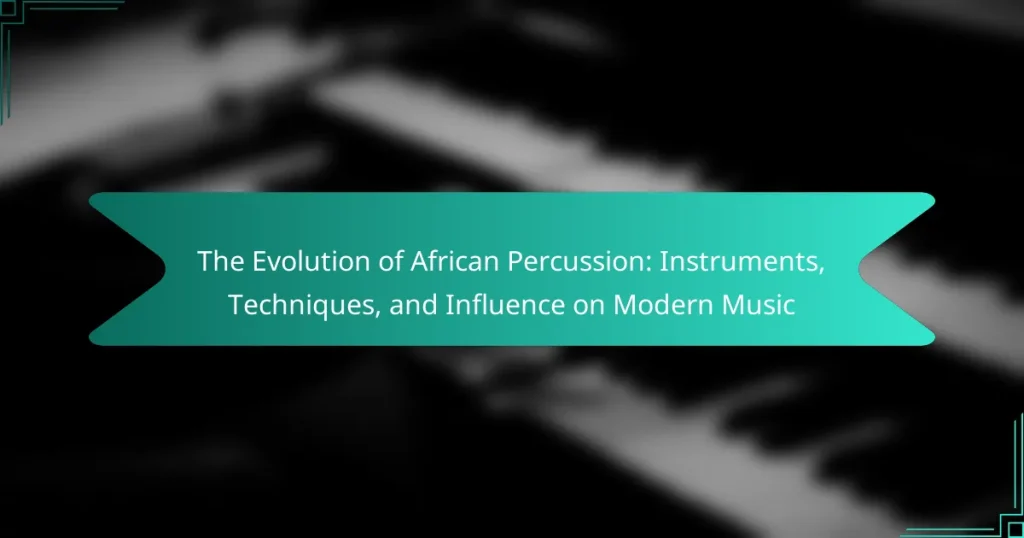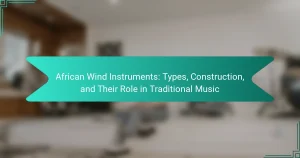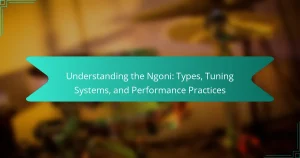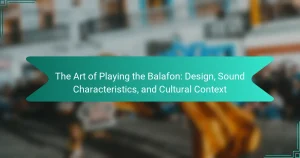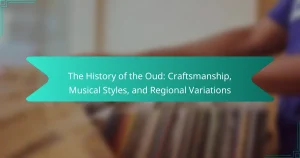African percussion encompasses a wide range of traditional instruments, including drums, shakers, and bells, which have evolved over centuries to reflect diverse cultural practices and communal rituals. Initially crafted from natural materials, these instruments have absorbed influences from trade and migration, leading to innovations in sound and technique. The djembe, a prominent West African drum, exemplifies this evolution, gaining global popularity. In the 20th century, African percussion significantly impacted various music genres, including jazz, rock, and hip-hop, as musicians integrated traditional rhythms into contemporary compositions. Today, African percussion remains vibrant, celebrated through festivals and workshops that honor its rich heritage and ongoing evolution.
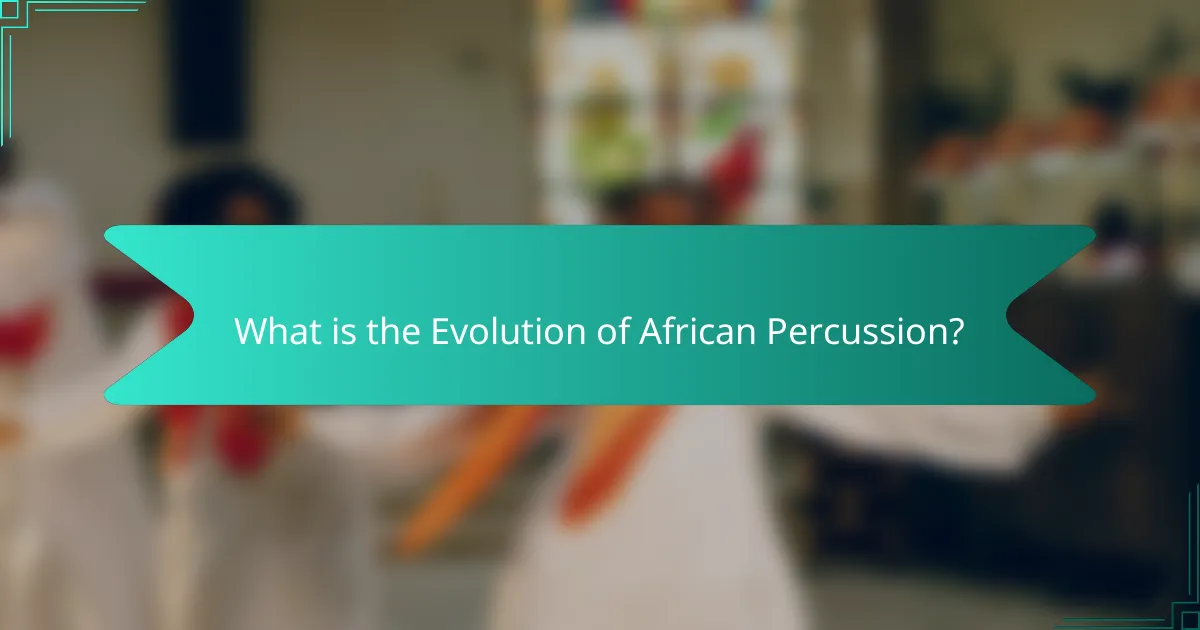
What is the Evolution of African Percussion?
African percussion has evolved over centuries, reflecting diverse cultures and traditions. Initially, it served spiritual and communal purposes in rituals and ceremonies. Instruments like drums, shakers, and bells were crafted from natural materials. The use of animal skins and wood created unique sounds specific to different regions.
As trade and migration occurred, African percussion absorbed influences from other cultures. The introduction of new materials and techniques expanded the variety of instruments. For example, the djembe, originating from West Africa, became popular globally.
In the 20th century, African percussion significantly influenced genres such as jazz, rock, and hip-hop. Musicians incorporated traditional rhythms into modern compositions. This blending of styles showcases the adaptability and resilience of African percussion.
Today, African percussion continues to thrive, with both traditional and contemporary forms being celebrated worldwide. Festivals and workshops promote its rich heritage, ensuring its evolution remains dynamic and relevant.
How did African percussion instruments originate?
African percussion instruments originated from ancient cultural practices and rituals. These instruments developed over thousands of years in various African societies. They were often made from locally available materials, such as wood, animal skins, and metal. The creation of these instruments was closely tied to community events, ceremonies, and storytelling.
Instruments like drums, rattles, and shakers were used to communicate, celebrate, and express emotions. The use of rhythm in these instruments played a significant role in social bonding and cultural identity. Historical evidence shows that percussion instruments were integral to African music long before the arrival of European colonizers.
Research indicates that the diverse styles of African percussion reflect regional differences and influences. This rich heritage laid the foundation for contemporary music genres, illustrating the lasting impact of African percussion on global music.
What are the historical contexts influencing African percussion?
Historical contexts influencing African percussion include cultural, social, and political factors. African percussion has roots in ancient rituals and ceremonies. These traditions often served religious or communal purposes. The transatlantic slave trade disrupted these practices but also facilitated cultural exchanges. African rhythms influenced musical styles in the Americas. Colonialism imposed new musical forms on African societies. Post-colonial movements revived traditional percussion practices. Each context shaped the evolution of African percussion. These influences continue to resonate in contemporary music.
Which cultures contributed to the development of these instruments?
Various cultures contributed to the development of African percussion instruments. West African cultures played a significant role, particularly the Yoruba and Akan people. These groups created intricate drumming techniques and unique instruments like the djembe and talking drum. Additionally, North African cultures, including Berber and Arab influences, introduced rhythms and styles that shaped percussion practices. The Bantu migrations spread musical traditions across sub-Saharan Africa, integrating diverse cultural elements. Each culture’s contributions reflect their social, spiritual, and communal values, enriching the overall evolution of African percussion.
What are the key types of African percussion instruments?
The key types of African percussion instruments include drums, rattles, and shakers. Drums are central to African music and come in various forms like djembe, talking drums, and congas. Rattles, often made from gourds or metal, add texture to musical performances. Shakers, such as shekeres, are used to create rhythmic patterns. These instruments are integral to cultural rituals and celebrations across the continent. Their diverse sounds contribute to the richness of African musical traditions.
What are the differences between traditional and modern African percussion instruments?
Traditional African percussion instruments are typically handcrafted from natural materials. They often feature unique designs that reflect cultural significance. Instruments like the djembe and talking drum are examples of traditional types. These instruments are used in specific cultural contexts and ceremonies.
Modern African percussion instruments often incorporate synthetic materials. They may also include electronic components for amplification and sound effects. Instruments like electronic drum pads and hybrid percussion instruments are examples of modern types. These instruments are used in contemporary music genres and fusion styles.
The primary difference lies in the materials and context of use. Traditional instruments emphasize cultural heritage, while modern instruments focus on versatility and innovation.
How do materials used in African percussion instruments affect their sound?
The materials used in African percussion instruments significantly affect their sound quality. Different materials produce distinct tonal characteristics. Wood, for example, offers warm tones with rich resonance. Metal creates sharper, brighter sounds with more sustain. Animal skins, commonly used for drum heads, provide a wide range of pitches and dynamic responses. The thickness and treatment of these skins can further alter the sound. Traditional instruments often incorporate local materials, enhancing cultural significance and sound authenticity. Research shows that specific combinations of materials can optimize sound projection and tonal clarity. This relationship between materials and sound is essential in the construction of instruments like the djembe and talking drum.
What techniques are used in African percussion?
African percussion techniques include polyrhythms, call-and-response patterns, and body percussion. Polyrhythms involve multiple contrasting rhythms played simultaneously. This technique is foundational in many African musical traditions. Call-and-response patterns create an interactive musical dialogue between the performer and the audience. Body percussion utilizes clapping, stomping, and vocal sounds to produce rhythmic patterns. These techniques enhance the communal aspect of African music. They also contribute to the rich texture and complexity of performances. Historical evidence shows these techniques have been integral to African cultures for centuries.
How do rhythm patterns vary across different African cultures?
Rhythm patterns vary significantly across different African cultures. Each culture has distinct musical traditions that influence their rhythmic structures. For example, West African music often features polyrhythms, where multiple contrasting rhythms are played simultaneously. In contrast, East African music may emphasize simpler, repetitive rhythms that create a steady pulse.
Moreover, the use of specific instruments also affects rhythm patterns. The djembe drum in Mali produces complex, layered rhythms, while the mbira in Zimbabwe focuses on interlocking patterns. Cultural celebrations and rituals further shape these rhythms, with each community incorporating unique elements reflective of their heritage.
Research shows that these variations are deeply rooted in the history and social contexts of the communities. For instance, the rhythm patterns in the music of the Ewe people from Ghana are tied to their storytelling traditions. This diversity highlights the rich tapestry of African musical expression.
What role does improvisation play in African percussion performances?
Improvisation is a fundamental aspect of African percussion performances. It allows musicians to express creativity and individuality within traditional frameworks. Each performance can vary significantly based on the improvisational choices made by the drummer. This spontaneity fosters a dynamic interaction between performers and their audience. In many African cultures, improvisation is seen as a way to convey emotions and tell stories. For instance, the use of call-and-response patterns often incorporates improvisational elements. This interaction enhances the communal experience of music-making. Research indicates that improvisation in African music traditions promotes cultural continuity while allowing for personal expression.
How does African percussion influence modern music?
African percussion significantly influences modern music by introducing unique rhythms and patterns. These rhythms often form the backbone of various genres, including jazz, rock, and hip-hop. Instruments like the djembe and conga have become staples in contemporary music settings. The call-and-response technique from African traditions enhances audience engagement in performances. Additionally, African drumming techniques promote polyrhythmic structures, which enrich musical complexity. Artists such as Paul Simon and The Roots have incorporated African percussion into their works, showcasing its versatility. Research indicates that African rhythms contribute to the development of groove and syncopation in modern compositions. This influence is evident in the global fusion of music styles today.
What genres of modern music incorporate African percussion elements?
Genres of modern music that incorporate African percussion elements include Afrobeat, reggae, hip-hop, and world music. Afrobeat blends traditional African rhythms with jazz and funk, creating a vibrant sound. Reggae often features African drumming patterns, emphasizing offbeat rhythms. Hip-hop samples African percussion, adding depth to beats and enhancing lyrical flow. World music encompasses various genres, integrating African instruments and rhythms into diverse styles. These genres showcase the global influence of African percussion, highlighting its adaptability and cultural significance.
How have African rhythms transformed contemporary musical styles?
African rhythms have significantly transformed contemporary musical styles by introducing complex polyrhythms and syncopation. These rhythmic patterns have influenced genres such as jazz, rock, and hip-hop. For example, the incorporation of African drumming techniques can be seen in the works of artists like Paul Simon and The Police. The use of call-and-response structures, rooted in African musical traditions, is prevalent in modern pop and R&B. Additionally, African rhythms have contributed to the global fusion of musical styles, creating new genres like Afrobeat. This transformation highlights the adaptability and influence of African musical heritage in contemporary music.
What are the challenges in preserving African percussion traditions?
The challenges in preserving African percussion traditions include cultural dilution, generational gaps, and commercialization. Cultural dilution occurs as globalization influences local practices. Many younger individuals may prioritize modern music over traditional forms. Generational gaps arise when elders who hold knowledge pass away without transferring their skills. Commercialization often leads to the simplification of complex rhythms for mass appeal. Additionally, the lack of documentation makes it difficult to record and teach these traditions. The diversity of regional styles complicates standardization, making preservation efforts inconsistent.
How do globalization and modernization impact traditional African percussion?
Globalization and modernization significantly influence traditional African percussion. They introduce new musical styles and instruments to African cultures. This exposure leads to hybrid forms of music where traditional rhythms blend with global genres. For example, the incorporation of electronic instruments alters traditional playing techniques. Modern communication technologies facilitate collaboration between African musicians and international artists. This interaction often results in the commercialization of traditional music. Additionally, globalization can lead to the dilution of cultural authenticity. Some traditional practices may be abandoned in favor of more popular, modern forms.
What efforts are being made to sustain these musical practices?
Efforts to sustain African musical practices include educational programs and community workshops. These initiatives aim to teach traditional percussion techniques to younger generations. Cultural organizations actively promote local musicians and their art forms. Collaboration between musicians fosters innovation while preserving traditional sounds. Festivals celebrating African music provide platforms for exposure and appreciation. Documentation of oral histories and musical practices helps in maintaining cultural heritage. Funding from government and non-profit organizations supports these efforts. Research initiatives also contribute by studying and archiving traditional music forms.
What practical tips can musicians use to incorporate African percussion into their work?
Musicians can incorporate African percussion by studying traditional rhythms and instruments. Learning the specific techniques used in African drumming is essential. Practicing with instruments like the djembe or talking drum can enhance their skill set. Collaborating with African percussionists provides authentic insights. Experimenting with layering African rhythms in compositions enriches musical texture. Using digital audio workstations to sample African percussion sounds can broaden creative possibilities. Attending workshops focused on African percussion promotes hands-on learning. Engaging with cultural contexts deepens understanding and respect for the music.
The main entity of the article is African percussion, which encompasses a variety of instruments, techniques, and cultural influences. The article examines the historical evolution of African percussion, detailing its origins, the types of instruments used, and the impact of various cultures on its development. It highlights the significance of traditional and modern techniques, the role of improvisation, and the influence of African rhythms on contemporary music genres. Additionally, the article addresses challenges in preserving these musical traditions amidst globalization and modernization, while outlining efforts to sustain and promote African percussion practices today.
